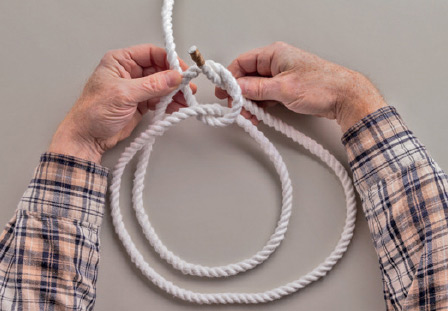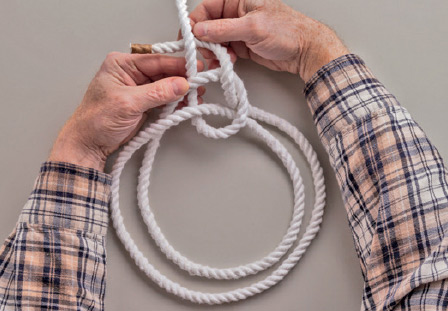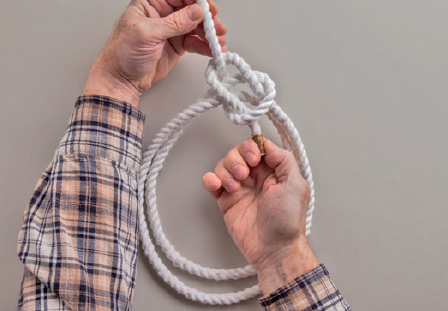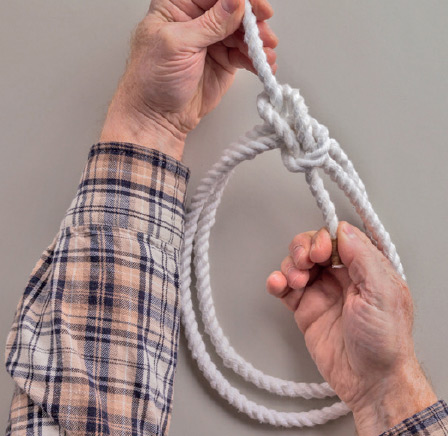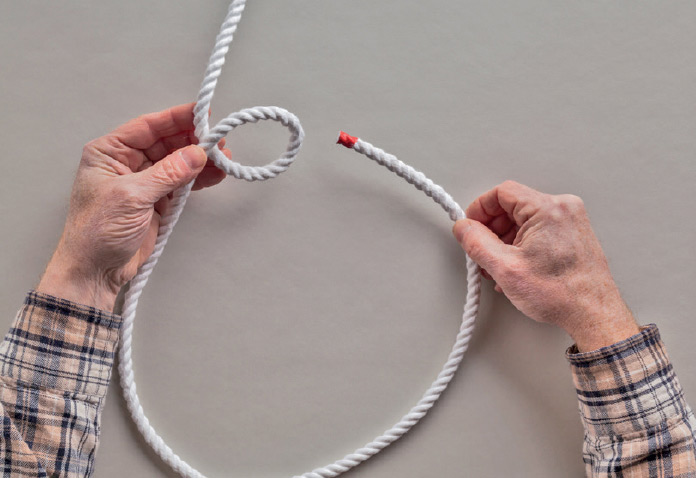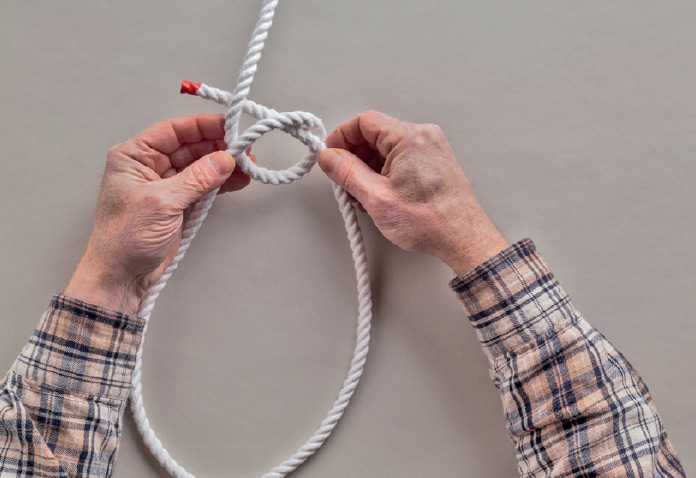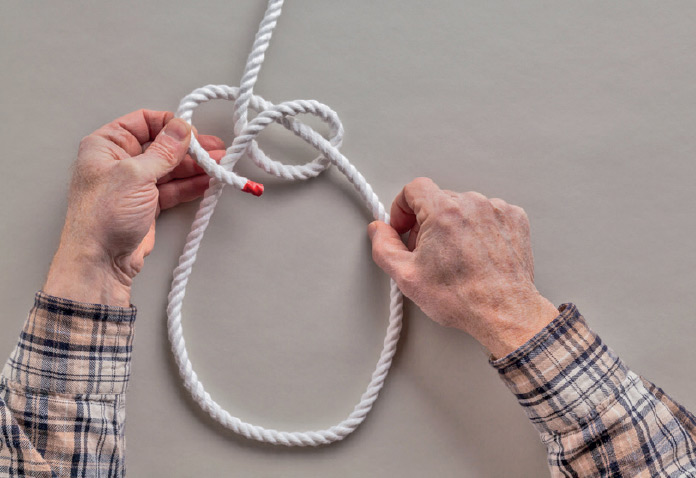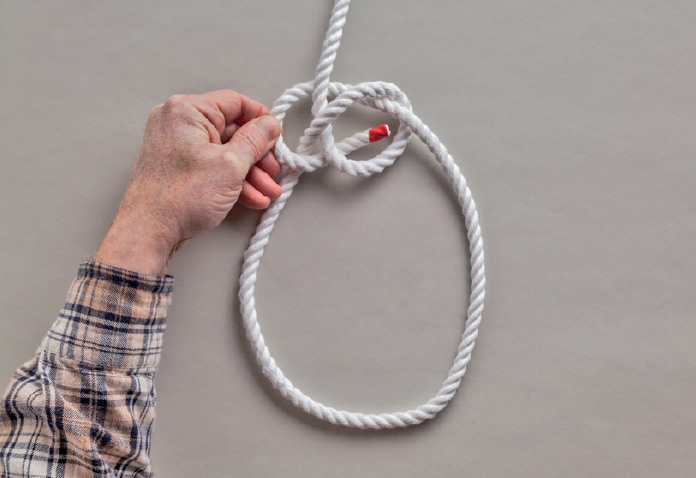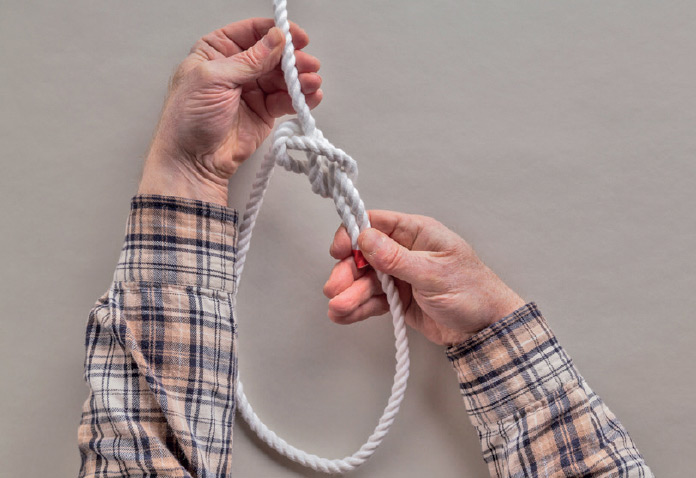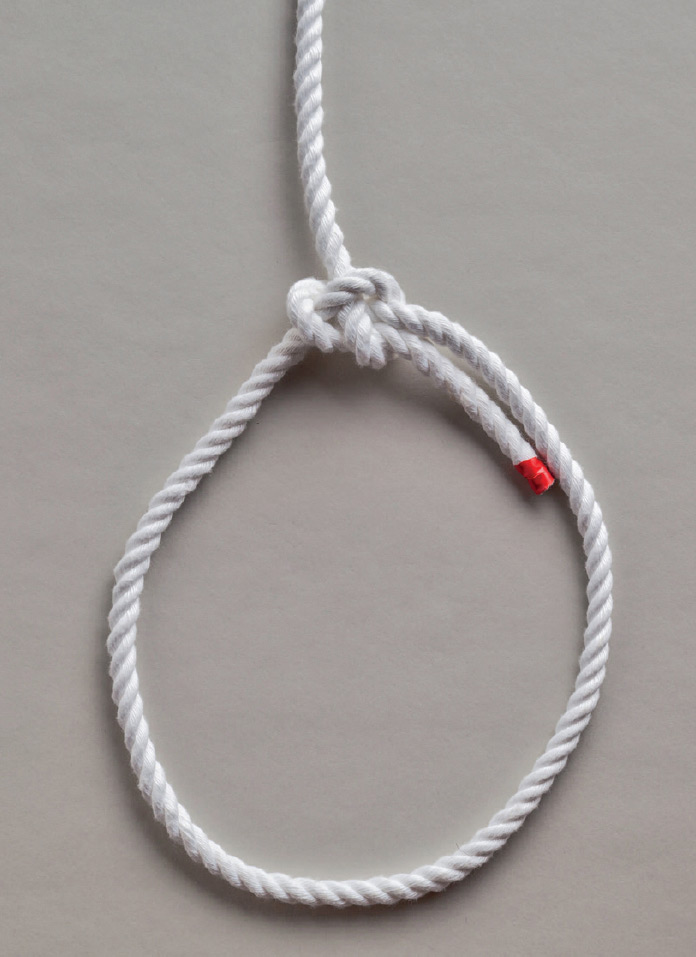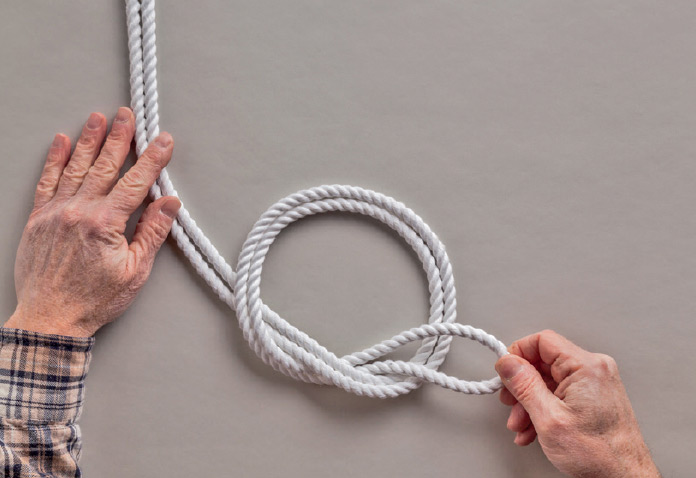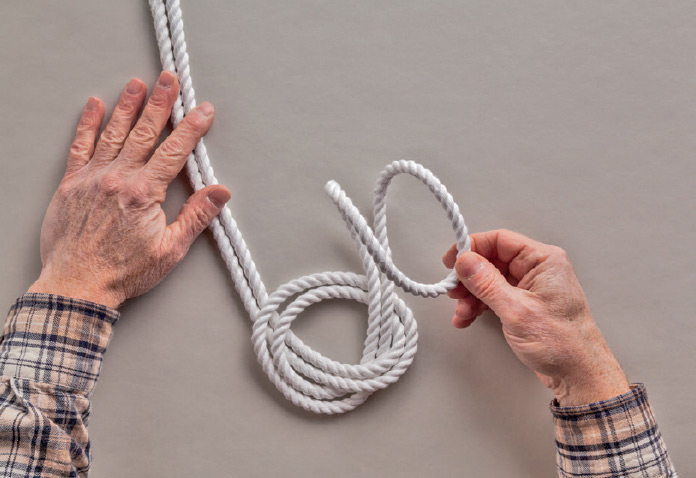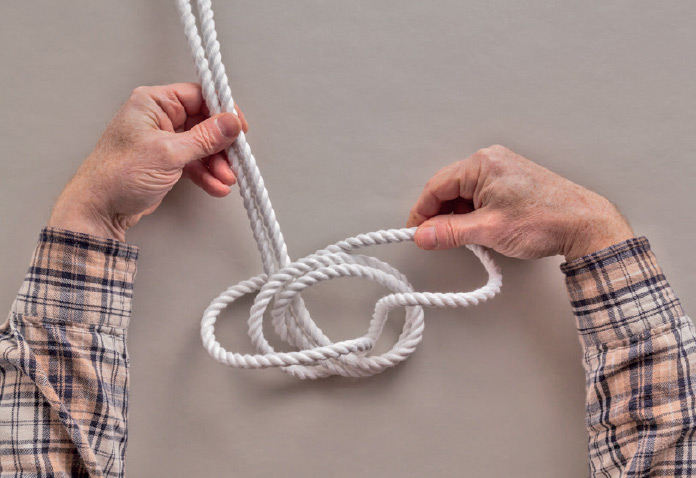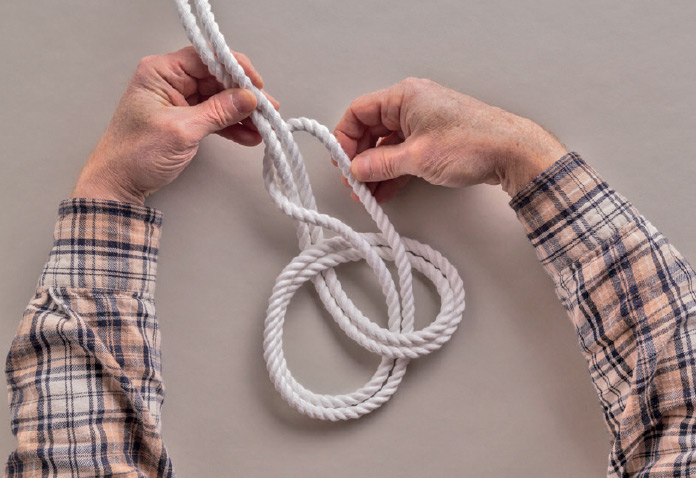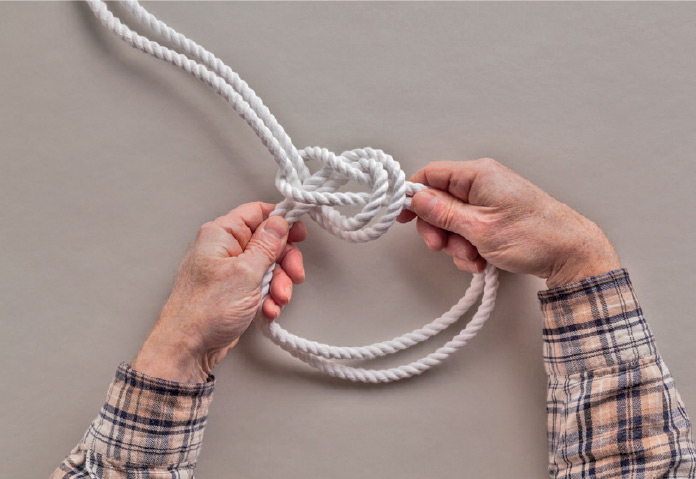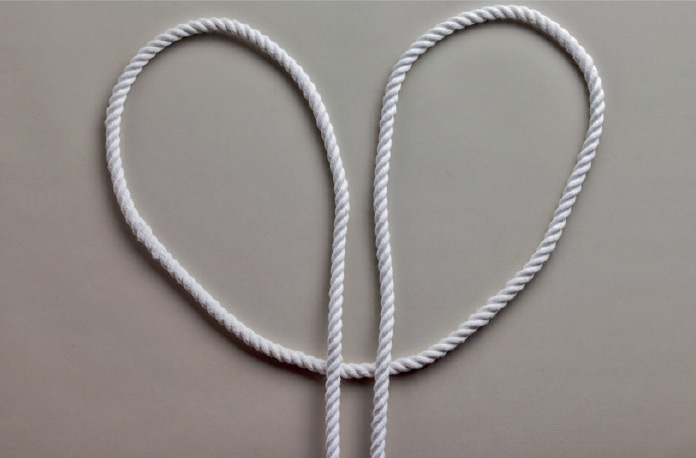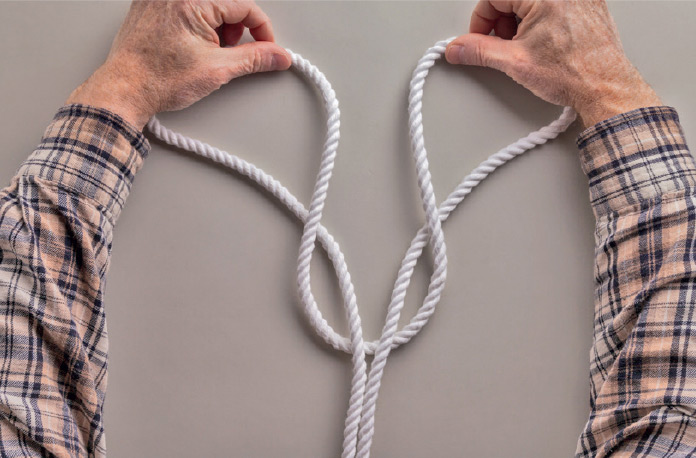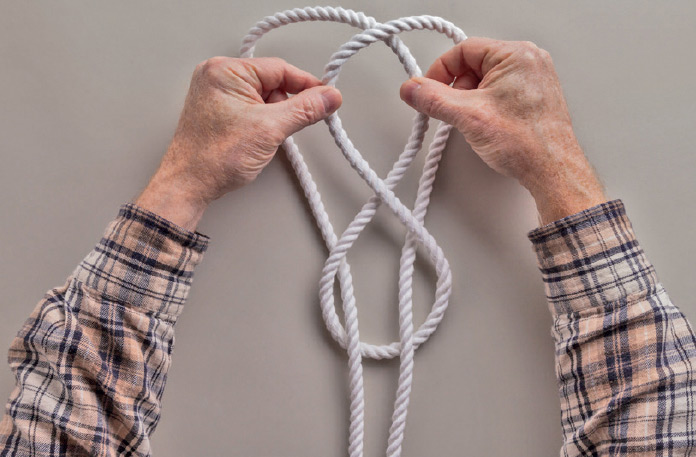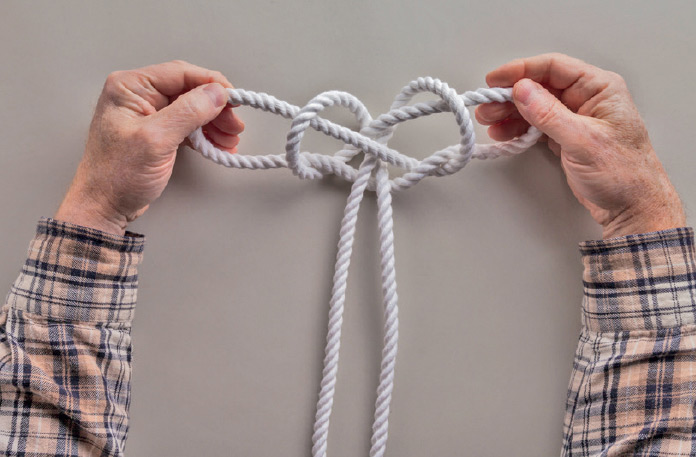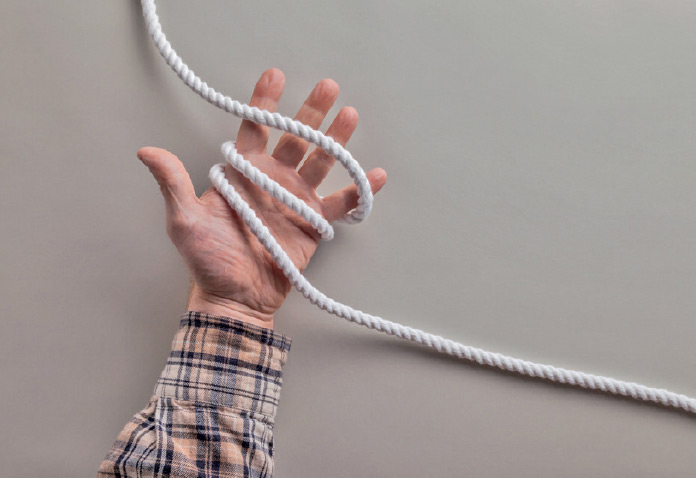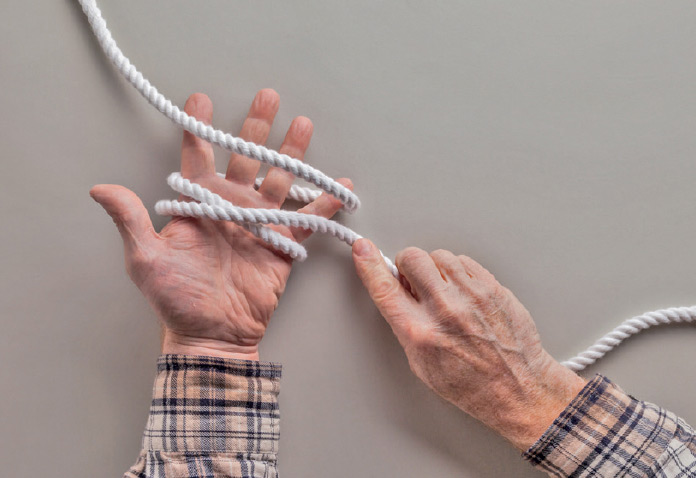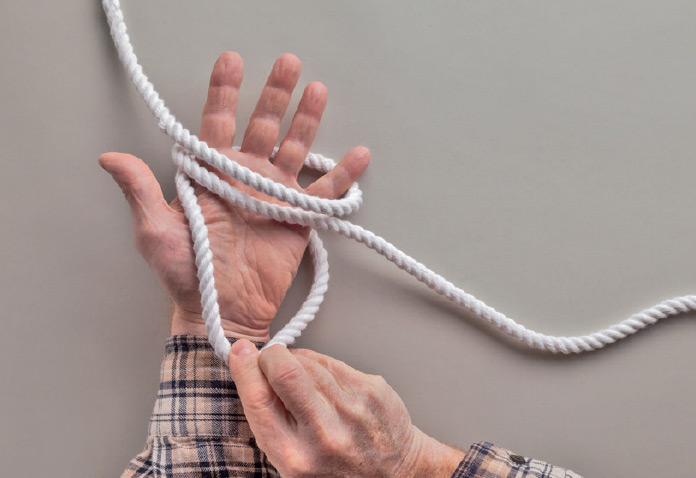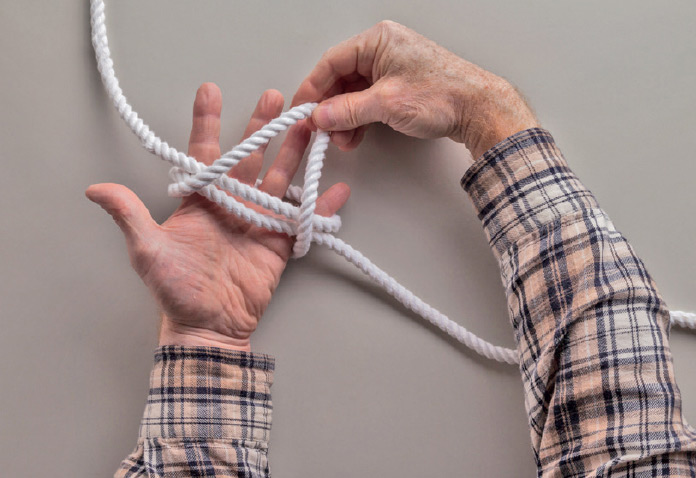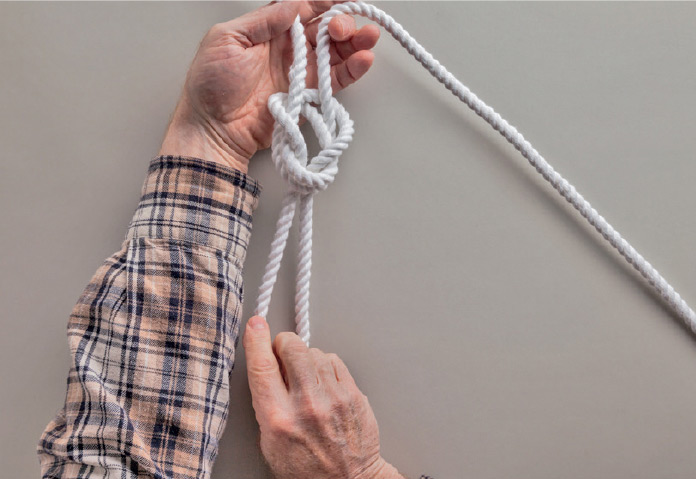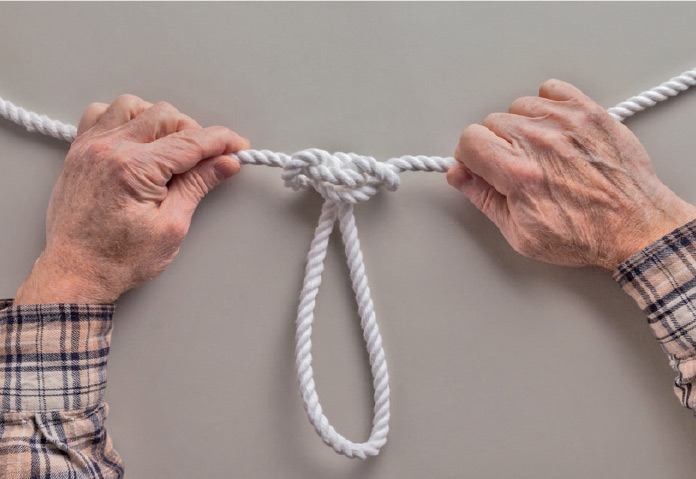Part Five
Loop Knots
Loop knots are easy enough to understand, but difficult to define precisely. Like hitches, they are tied to fit around objects (or people), but they are not intended to bind objects together (that’s the job of binding knots). Loop knots may be tied at the end of a rope or anywhere along its length (on a bight). They may be of a fixed size or they may be adjustable. Unlike a hitch, which is tied on an object and depends upon that object for its structure, loop knots may be tied in the rope itself and then placed on the object when finished. Loop knots are useful for lifting and pulling objects and, in the form of a safety harness or bosun’s chair, to lift or secure people as well. (Observe all safety recommendations in this book when using rope for these purposes.) A pair of interconnected loop knots can also be used in place of a bend to make a strong and durable connection between the ends of two ropes.
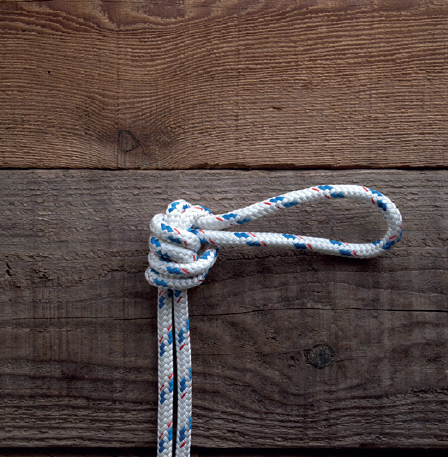
26.
Uses: lifting, hauling, hanging gear from doubled line
Pros: easy to tie; works well with small stuff
Cons: difficult to untie; only appropriate on a bight
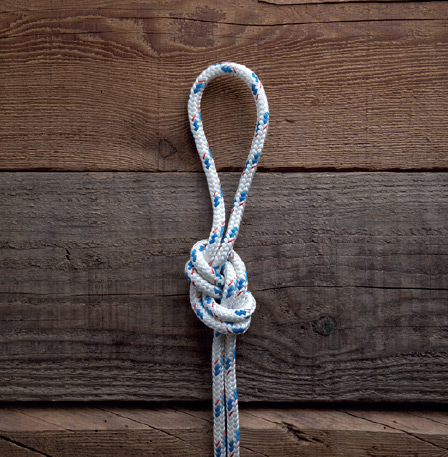
27.
Uses: lifting, pulling, hanging loop for gear; tie-in point for climbers
Pros: easy to tie in rope of any thickness; fairly easy to untie; very strong
Cons: not as easy to untie as a Bowline
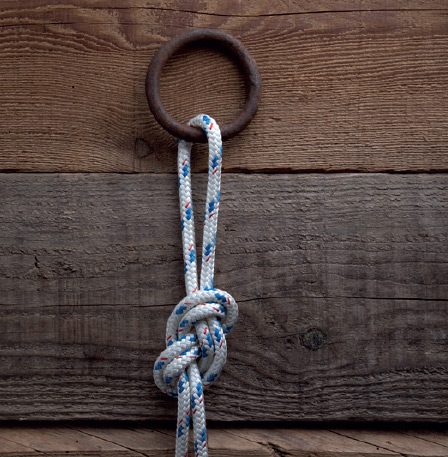
28.
Uses: lifting, pulling, hanging loop for gear; belaying climbers
Pros: very strong and secure
Cons: fussy to tie
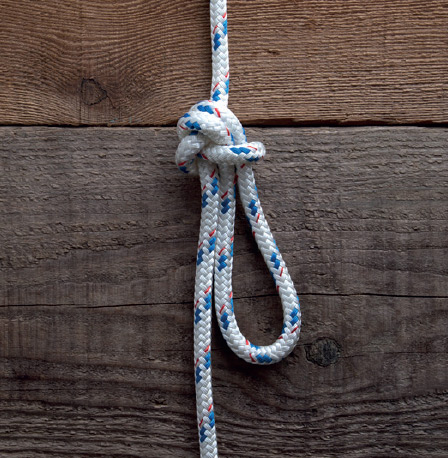
29.
Uses: climbing, lifting, load bearing
Pros: easily tied; very strong
Cons: will slip if loaded in wrong direction; dangerous to careless users; hard to untie

30.
Uses: general-purpose tie-off or hanging point; fishing tackle
Pros: easy to tie; relatively secure
Cons: hard to make with a small loop; difficult to untie in small stuff; may slip
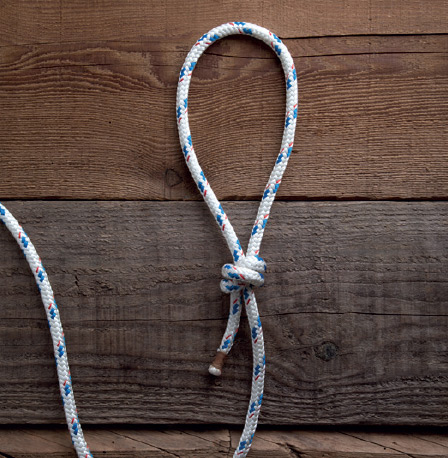
31.
Uses: fishing, general-purpose noose
Pros: easy to tie; works well with small stuff; tightens easily
Cons: difficult to untie
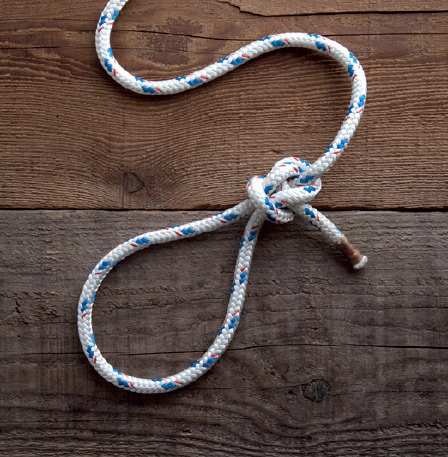
32.
Uses: fishing leaders, tippets and hooks, loops in bungee cord
Pros: holds well in any material
Cons: very difficult to untie; hard to fair and tighten in heavy rope
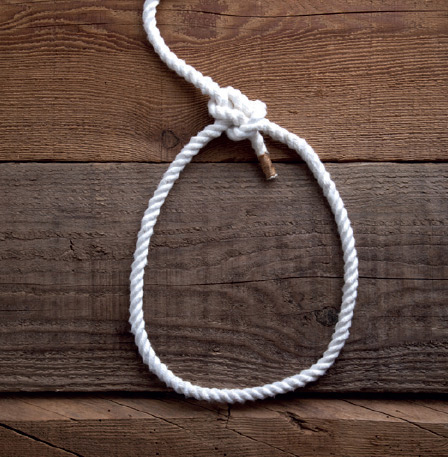
33.
Uses: lifting, connecting rope ends, sail-to-sheet connections, docklines
Pros: secure under load; easy to tie and untie
Cons: can capsize if not loaded; not the most secure form of bowline

34.
Uses: lifting, personal safety, connecting rope ends; sail-to-sheet connections, docklines
Pros: more secure than standard Bowline; controls excessively long working end
Cons: more time-consuming than standard Bowline

35.
Uses: general lifting, personal safety, connecting ends of two ropes, sail-to-sheet connections, docklines
Pros: secure; easy to tie, easy to untie
Cons: can capsize and slip; not the most secure form of bowline
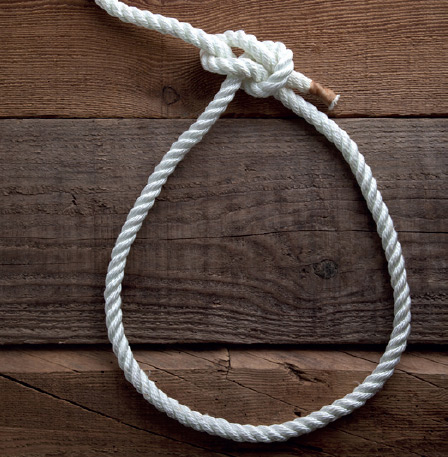
36.
Uses: lifting large, heavy loads
Pros: working end is on outside of loop, unlike standard Bowline
Cons: less secure than standard Bowline
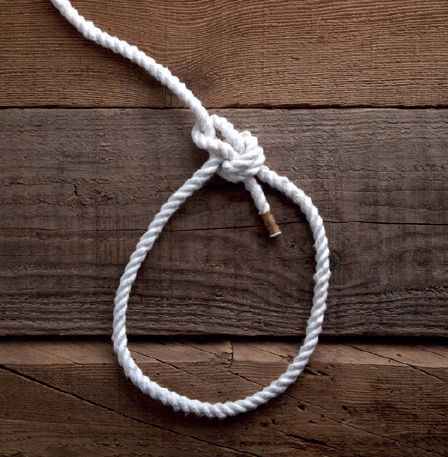
37.
Uses: general lifting, climbing, personal safety
Pros: very secure, easy to untie
Cons: bulkier than standard Bowline; requires more rope

38.
Uses: general lifting and pulling, safety; docklines, especially in wet, slippery rope
Pros: extremely secure
Cons: uses more rope, trickier to tie than regular Bowline

39.
Uses: lifting large, heavy loads
Pros: secure, adjustable size loops, unties readily
Cons: loops can shift
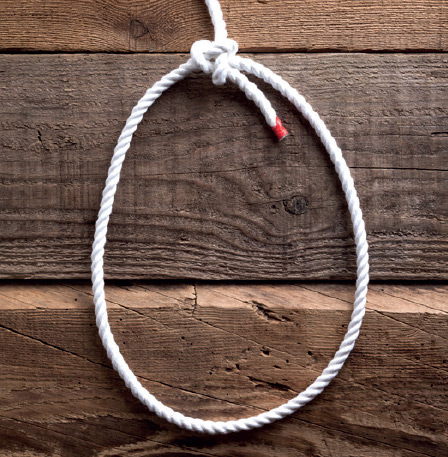
40.
Uses: lifting, pulling, safety; may be used as a hitch
Pros: very secure, especially in slippery rope
Cons: tricky to tie and fair

41.
Uses: lifting, hauling, safety, climbing
Pros: very secure and strong, easy to untie, can use one or both loops
Cons: insecure if both standing parts are not loaded
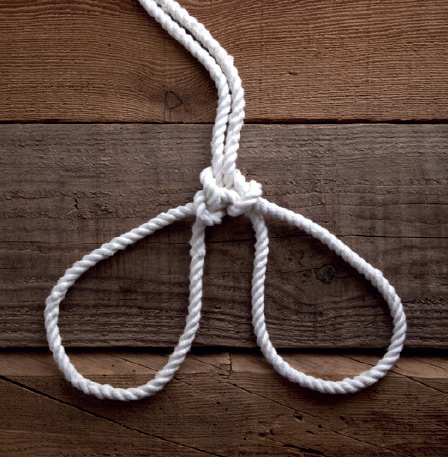
42.
Uses: lifting large heavy loads, bosun’s chair, or rescue harness
Pros: loops will not shift under load
Cons: difficult to tie with loops of unequal size

43.
Uses: mid-rope tie-off point, purchase for tightening a line
Pros: easy and quick to tie; suitable for loads in either direction
Cons: only useful on a bight; awkward to tie large loops
, to which it is very closely related, the Double Overhand Loop shares the liability of most overhand knots in being difficult to untie. It is one of the easiest ways to form a loop on a bight, and fairly attractive withal. Instructions
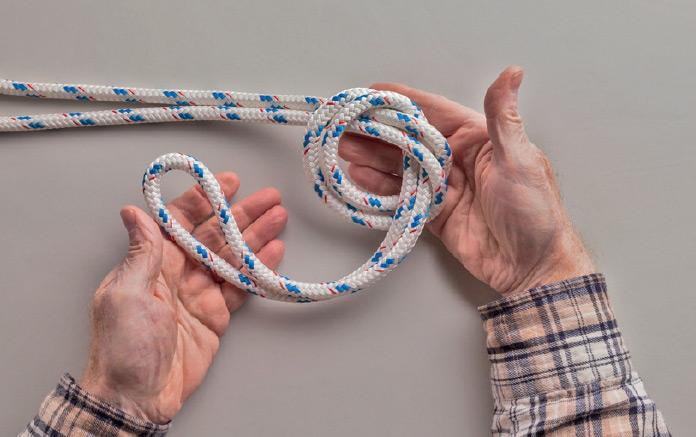
1. Make an with a bight.
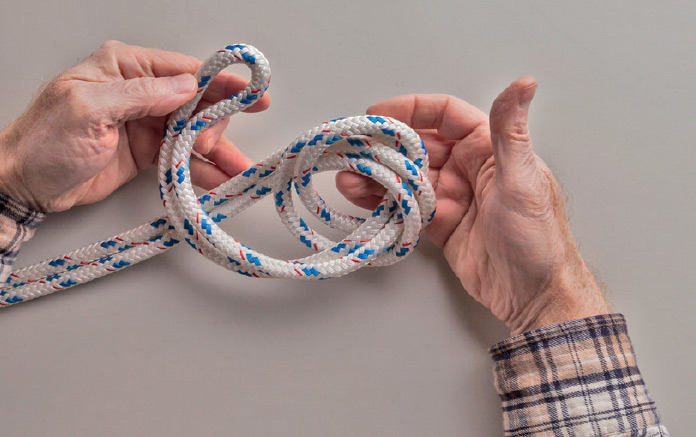
2. Bring the bight around the standing parts.
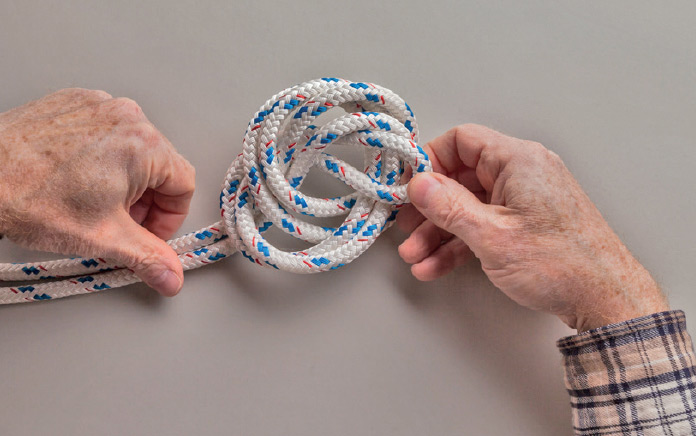
3. Pass the bight a second time through the crossing turn to complete the Double Overhand Knot on the bight.

4. Pull the loop against the two standing parts to tighten. Fair the knot by laying the four crossing turns close against each other.
, but on a bight. The bight may be placed near the working end of the rope or anywhere along its length. Tied in the middle, it provides a good tie-off point at the bottom of a rope that has been doubled for strength. The knot reduces the strength of the rope less than most other loop knots. Instructions
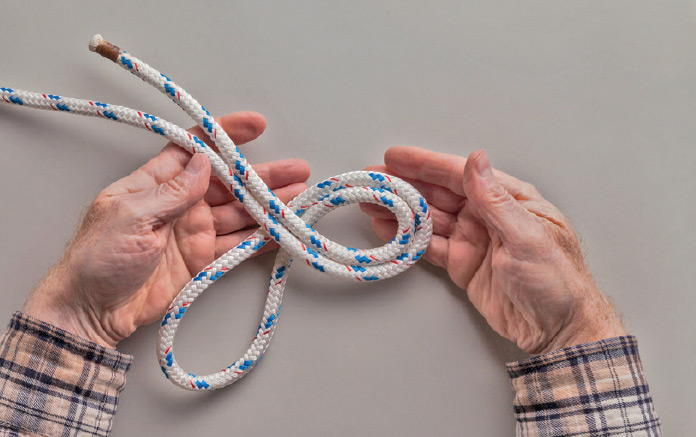
1. Make a bight anywhere along the rope. Make a counterclockwise underhand crossing turn in the bight.
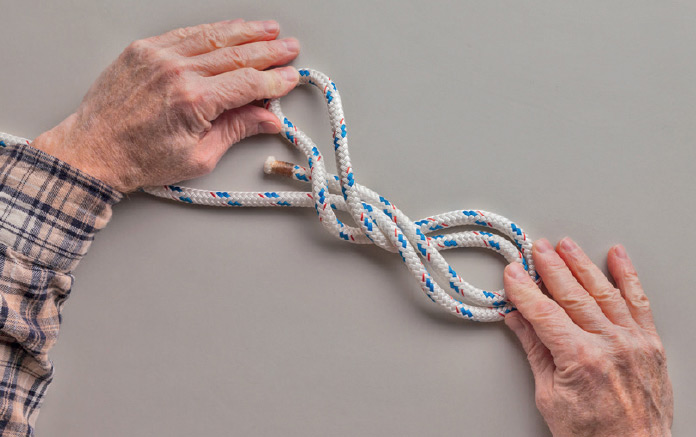
2. Take the end of the bight over the doubled rope.
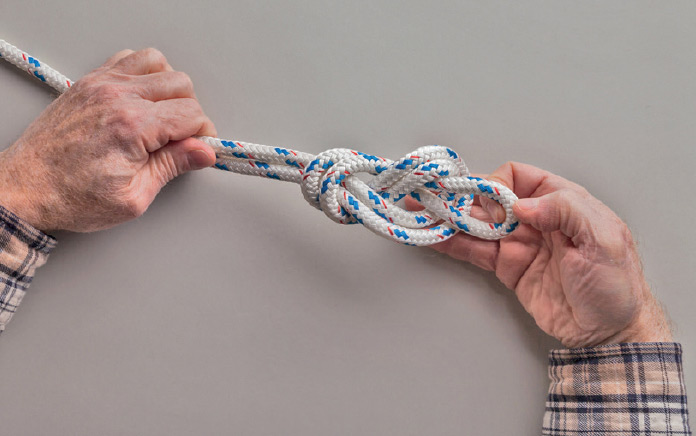
3. Pass the bight through the doubled crossing turn from back to front to complete the figure 8.
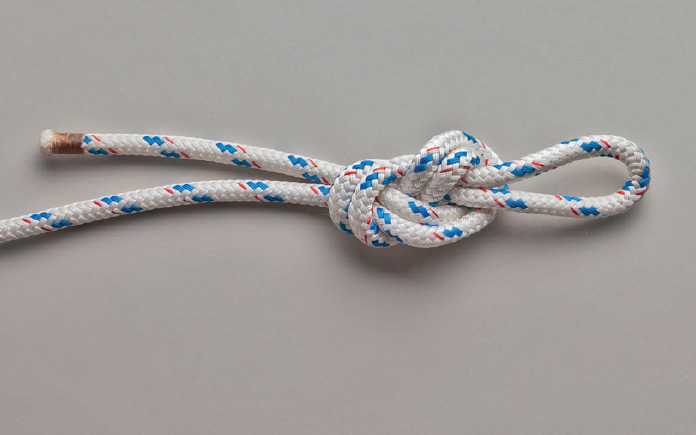
4. Fair the knot so the doubled strands are parallel all the way through.
is tied with the working end, not on a bight, so it can be used to tie off to closed rings, or to make a loop around an object whose end is not accessible. It creates a fixed single loop. Instructions
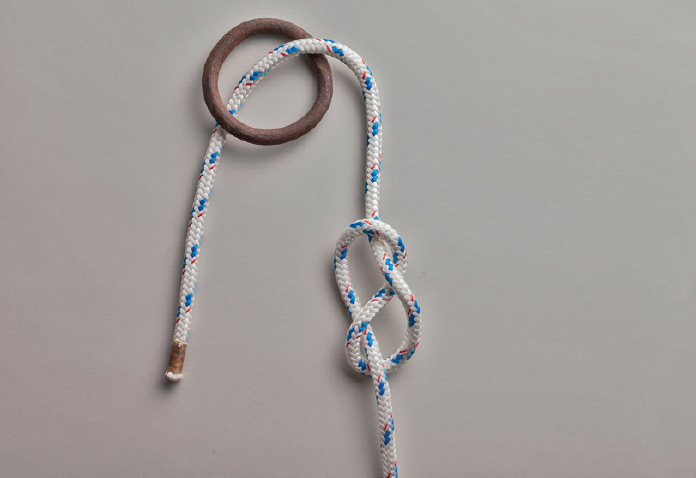
1. Start with a standard , leaving a working end somewhat longer than the desired loop. Pass the working end through the ring or around the tie-off point to form the loop.
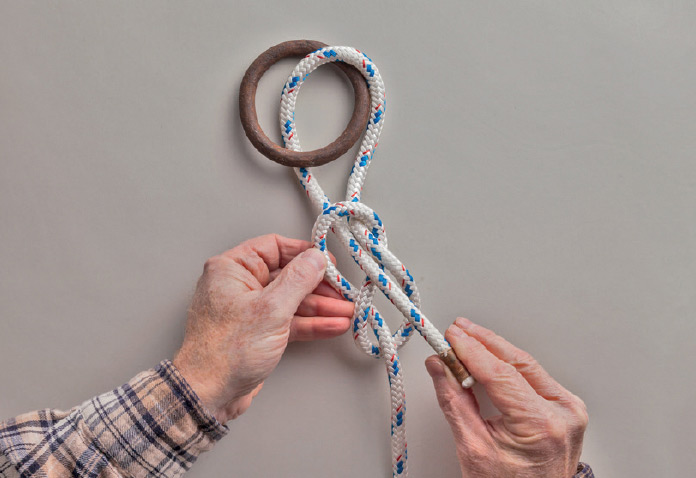
2. Thread the working end back through the upper crossing turn, next to and parallel with the working end where it exits the figure 8, but in the opposite direction.
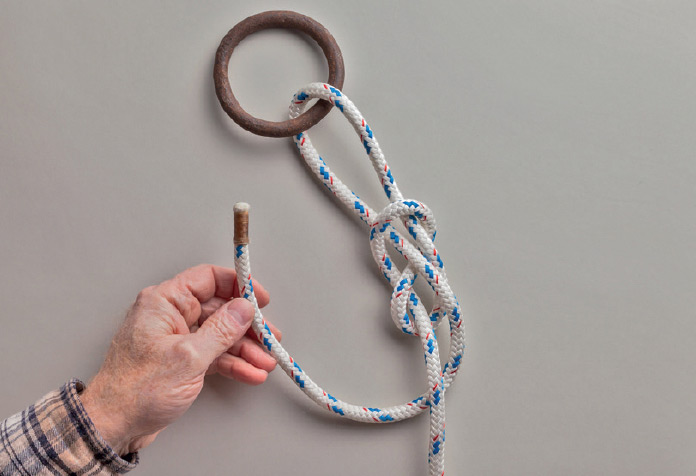
3. Pass the working end behind the standing part, always working parallel to the course of the figure 8.
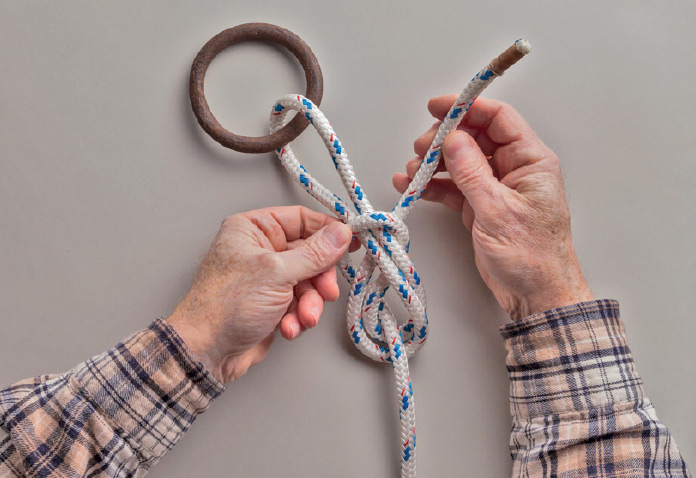
4. Pass the working end through the upper crossing turn of the figure 8, threading it beneath the two strands that form the loop.
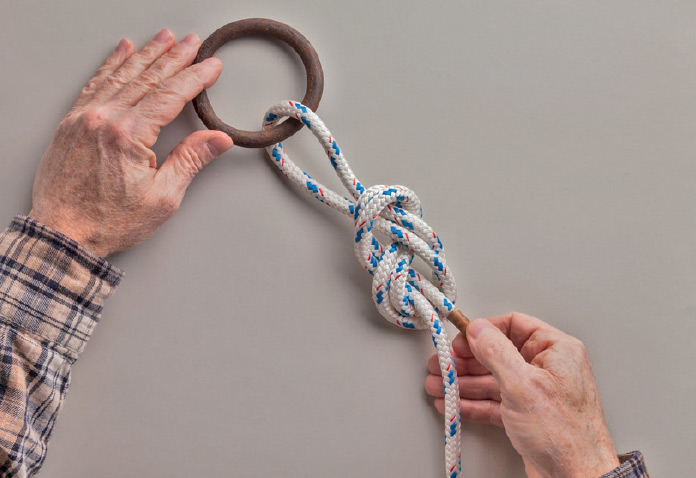
5. Still working parallel to the original figure 8, pass the working end around both legs of the loop, then back down through the (now doubled) lower crossing turn, parallel with the standing part.
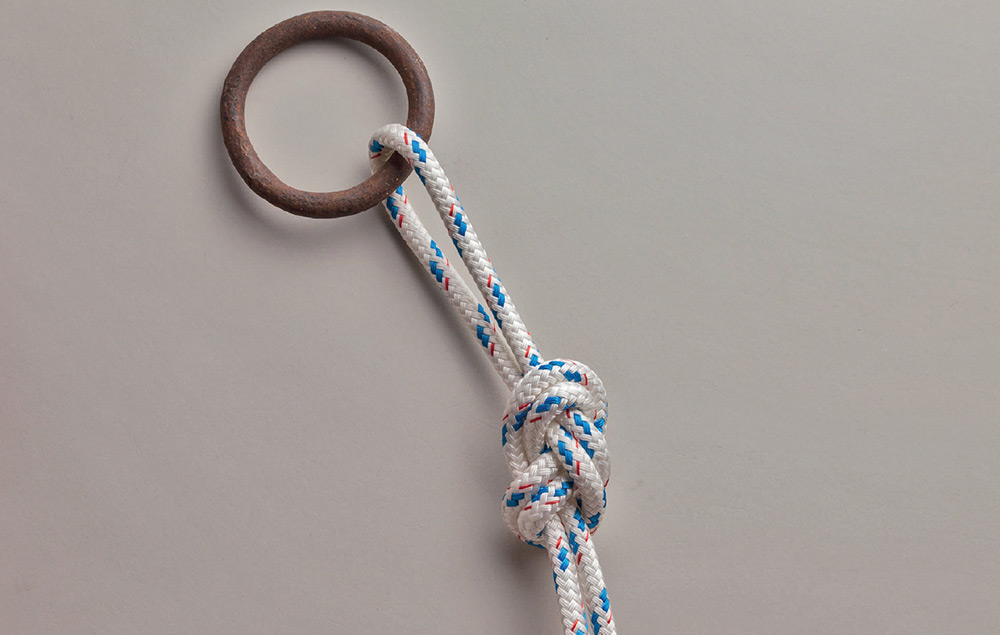
6. To tighten, hold the working end together with the standing part and pull against the loop. Then release the working end and pull the standing part against the loop.
, it is simple to tie but a little tricky to get the size of the loop exactly as desired. Instructions

1. Make a counterclockwise overhand crossing turn. Form a bight near the working end and pass it through the turn from back to front. In other words, make a and draw it tight.
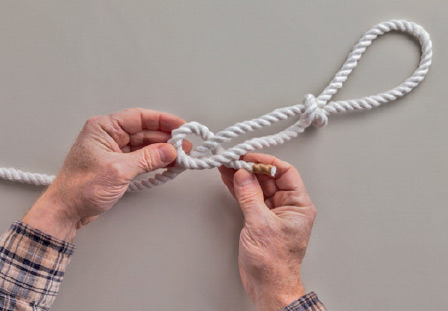
2. Make a clockwise underhand crossing turn with the working end around the standing part.
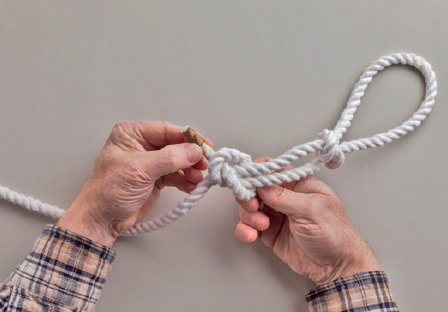
3. Pass the working end through the crossing turn to form an .
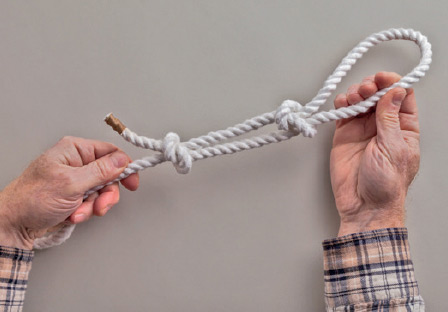
4. Pull the working-end leg of the loop against the standing part of the line to draw the overhand knots against each other.
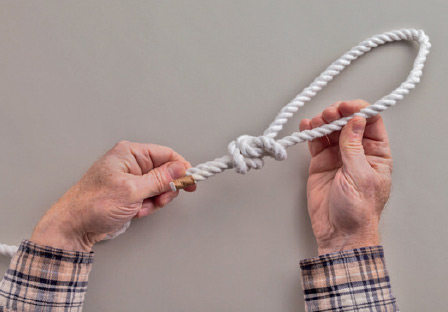
5. The finished knot.
tied in the working end around one strand of the loop will help prevent this. It is also a good way to make the knot tidier if the working end is too long. Instructions
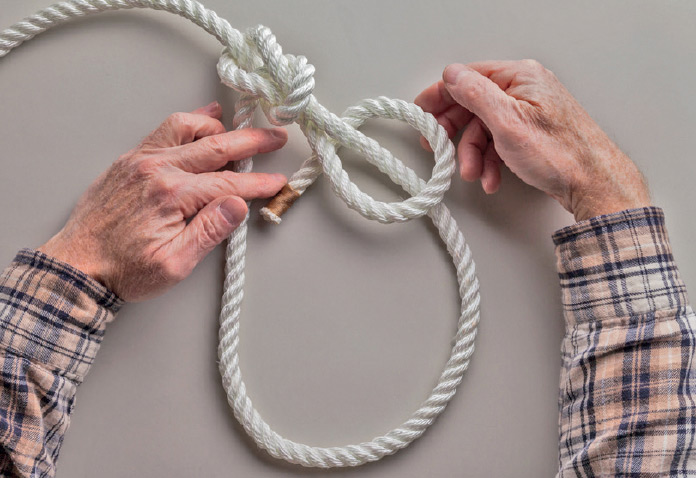
1. Tie a standard Bowline (opposite), leaving a longer working end than usual. Make an underhand crossing turn around the working-end leg of the loop.
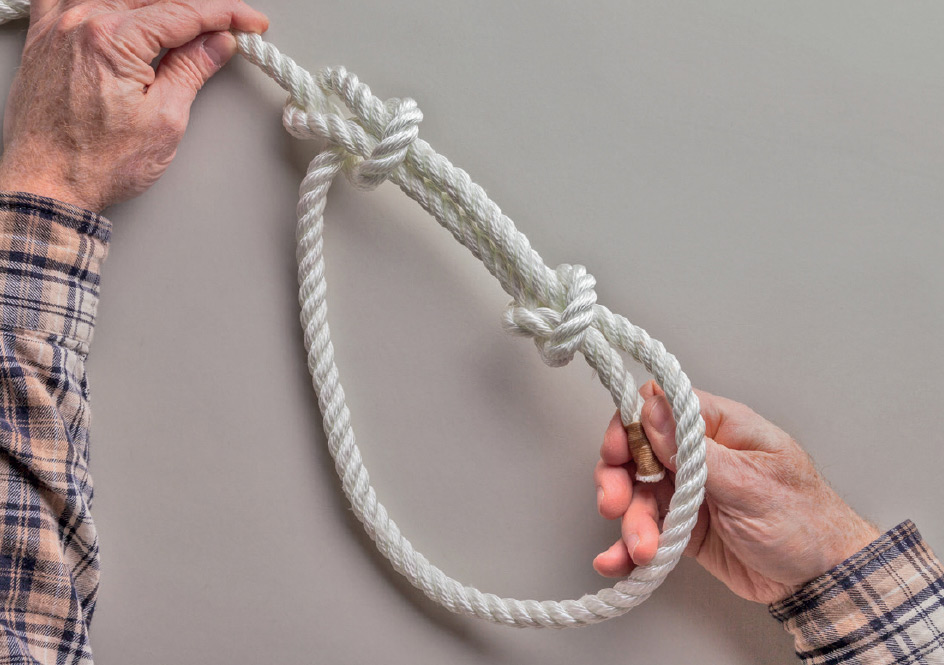
2. Bring the working end forward, and pass it through the crossing turn from front to back to form an Overhand Knot. Hold the standing part of the rope above the Bowline, and pull the Overhand Knot down and tighten.
with one hand because the other is occupied holding on to something for dear life. This method requires good manual dexterity, but it produces a standard Bowline with all its virtues. Instructions
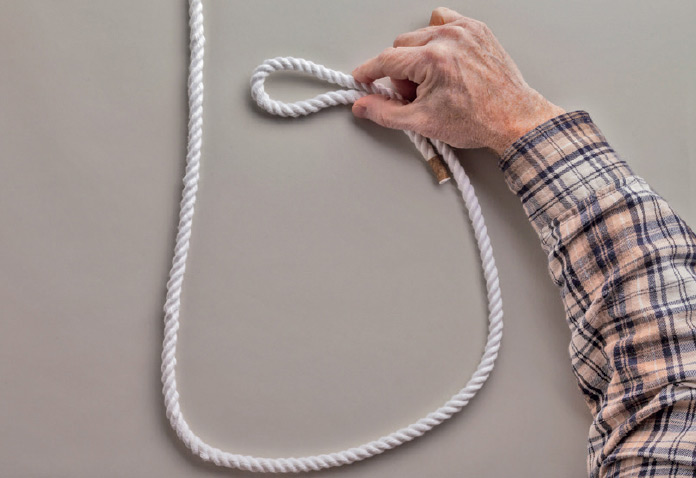
1. Form the body of the loop in the working end of the rope, then make a bight at the very end. (The bight is optional; it doesn’t form a part of the knot, but it’s easier to manipulate the working end this way.)
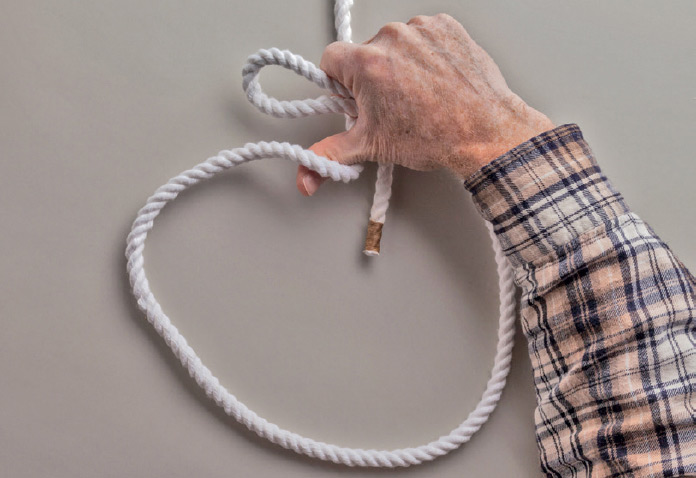
2. Holding the bight with your palm down, use your thumb to lift the standing part of the loop.
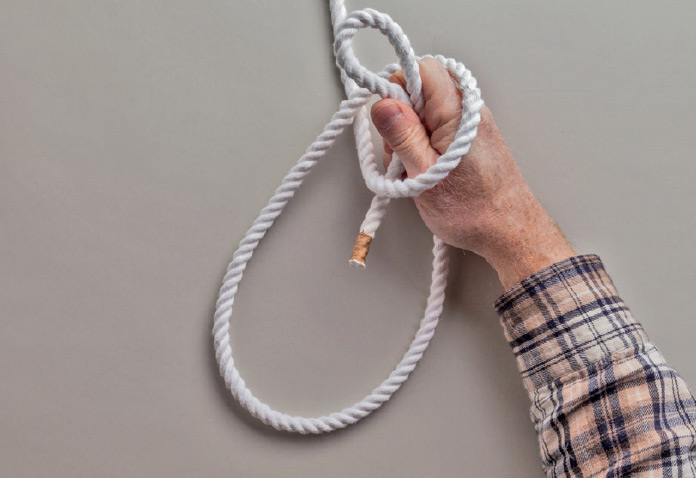
3. Twist your wrist up so that the standing part of the loop forms a counterclockwise overhand crossing turn over the bight in the working end. Be careful that the crossing turn does not form over your wrist, or you could find yourself entrapped.
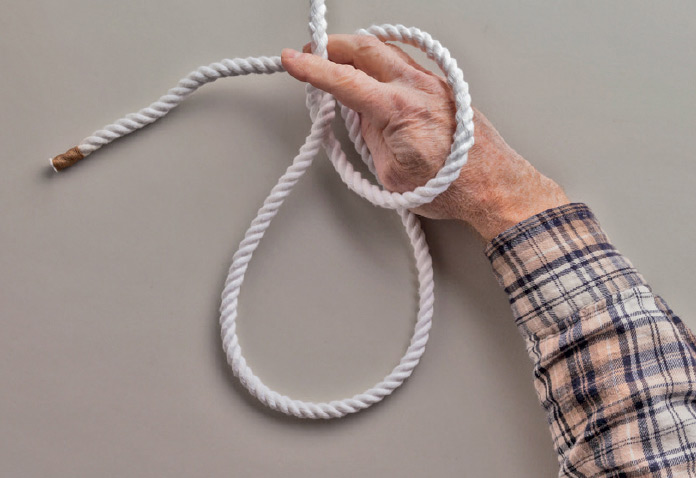
4. Undo the bight and pass the working end behind the standing part.
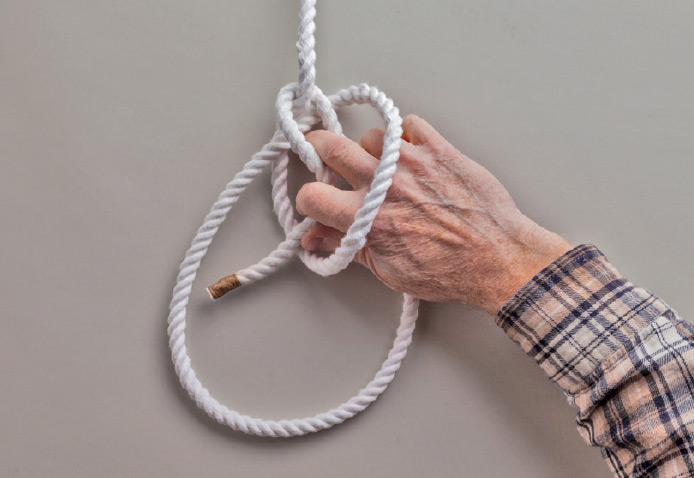
5. Pull the working end through the crossing turn from front to back.
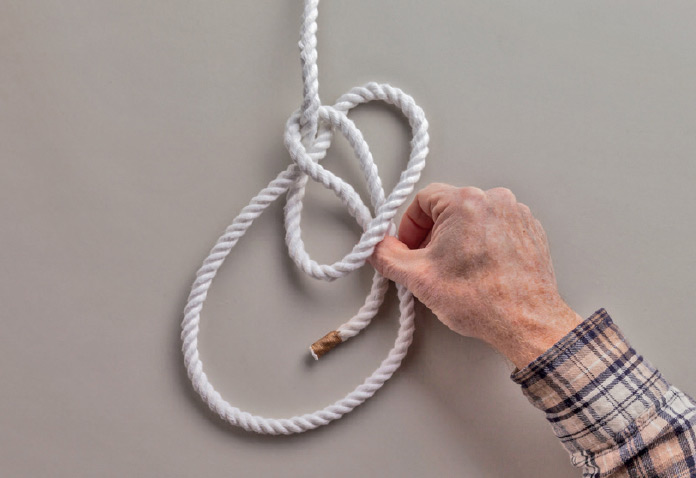
6. Continue to pull the working end through the crossing turn. Depending upon how large you want the loop, you might hold both strands of the new bight that you’ve created around the rope’s standing part and pull them together through the crossing turn.
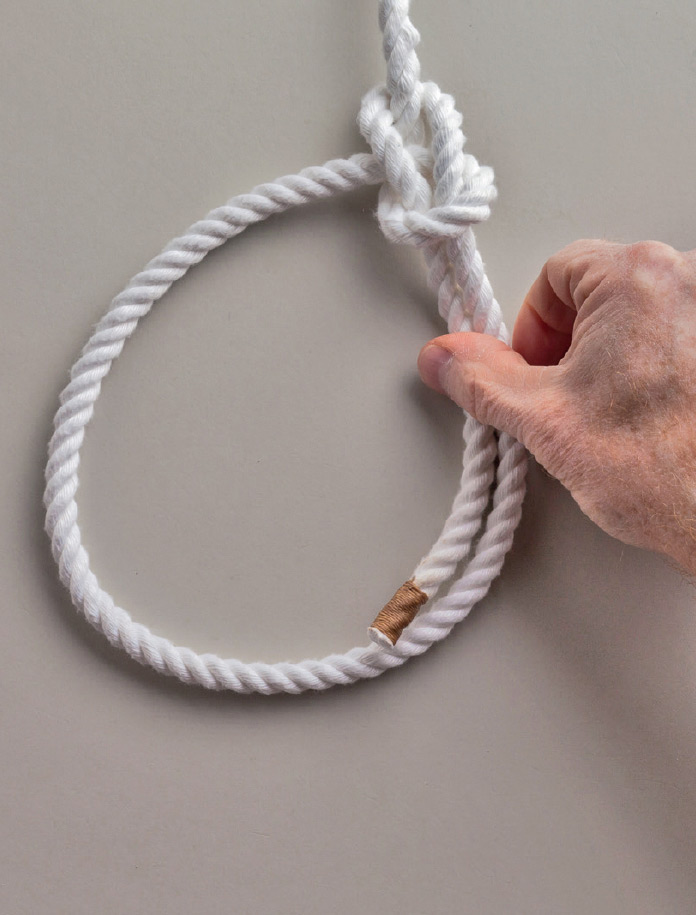
7. The finished Bowline.
positions the working end outside the loop. It is said to be somewhat less secure than a standard Bowline, but it does place the loop in more complete contact with the object it surrounds. If used as a safety line, it’s more comfortable this way, with the working end away from the torso. Instructions
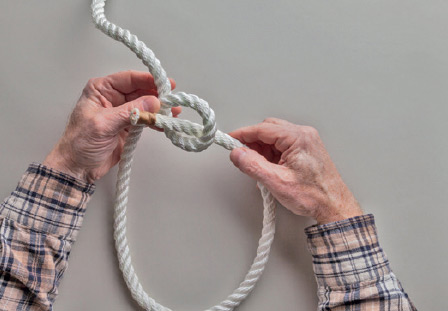
1. Begin like a standard Bowline. Leaving a long working end, make a small overhand counterclockwise crossing turn and pass the working end through the crossing turn from back to front. As the working end passes through the crossing turn, pass it perpendicular to the standing part.
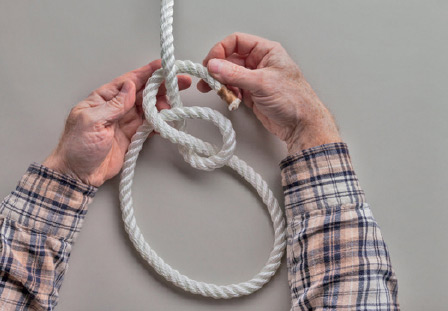
2. Pass the working end behind the standing part and bring it forward.
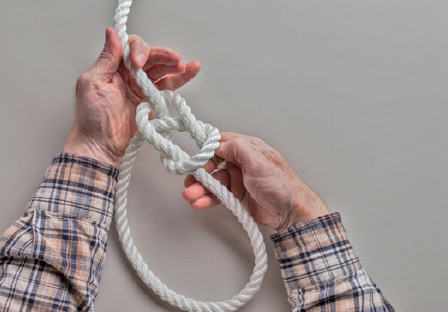
3. Bring the working end back through the crossing turn from front to back.
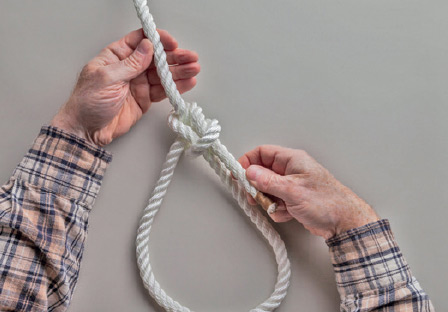
4. Tighten by pulling on the standing part and working end.
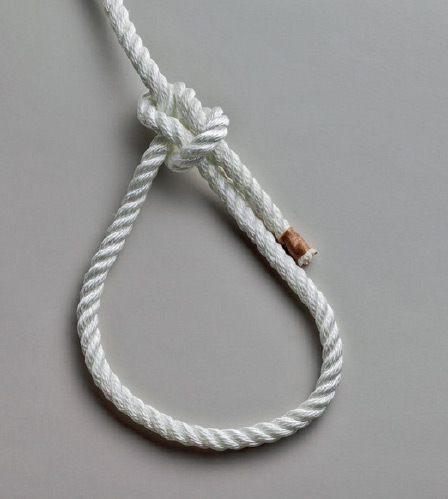
5. The finished knot, with the working end on the outside of the loop.
, this one’s simple: just replace the initial crossing turn with two round turns. Instructions
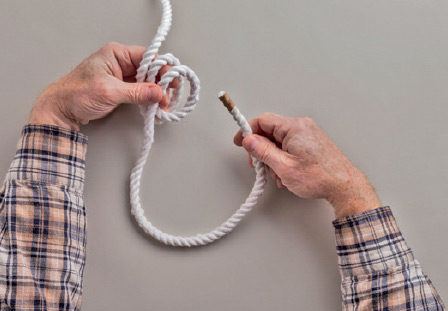
1. Make two counterclockwise round turns in the standing part, leaving the working end long enough to form the loop and complete the knot.
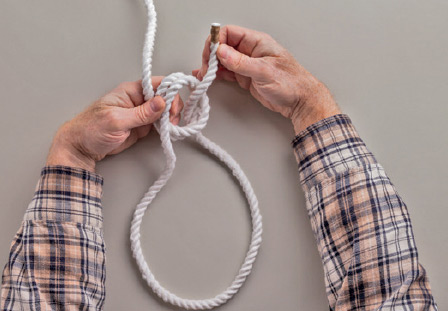
2. Pass the working end through the round turns from back to front.
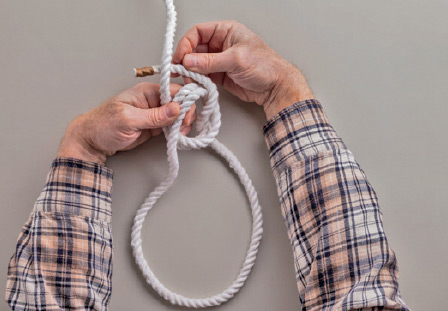
3. Pass the working end behind the standing part and bring it forward.
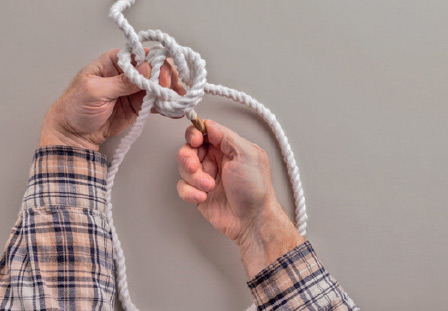
4. Pass the working end through the round turns from front to back.

5. Pull the working end and the standing part to tighten. The knot may need to be faired by pulling the standing-part leg of the loop against the standing part of the rope.
around the bight in the working end. It’s especially useful to maintain security in wet, slippery line, yet it can still be untied easily. Instructions
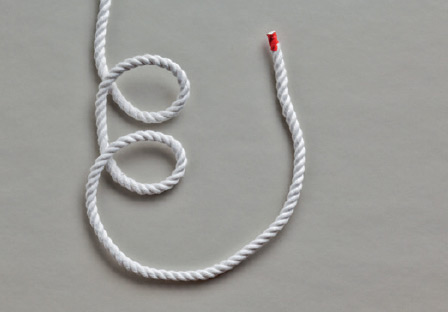
1. Make two counterclockwise overhand crossing turns in the standing part, leaving the working end long enough to form the loop and complete the knot.
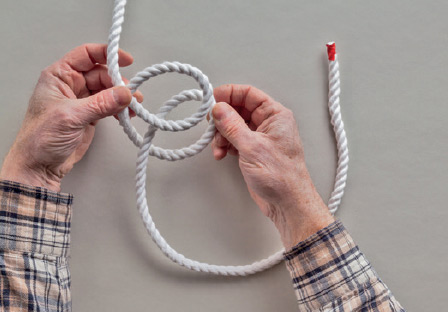
2. Shift the lower crossing turn (the one closer to the working end) under the upper one and hold them together.
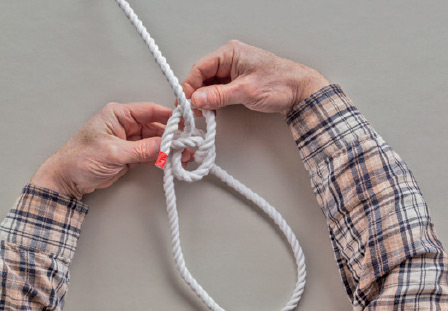
3. The rest of the procedure is the same as a standard . Pass the working end through the crossing turns from back to front, then behind the standing part.
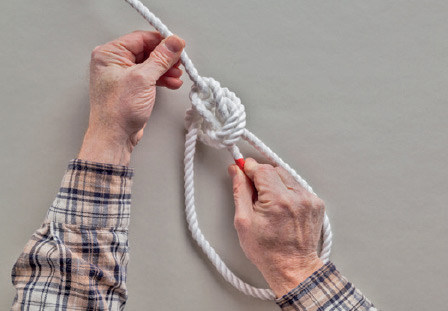
4. Pass the working end through the crossing turns from front to back. Hold both ends of the bight together in one hand while pulling on the standing part of the rope to tighten the upper Half Hitch. Then pull the standing-part leg of the loop to tighten the lower Half Hitch.
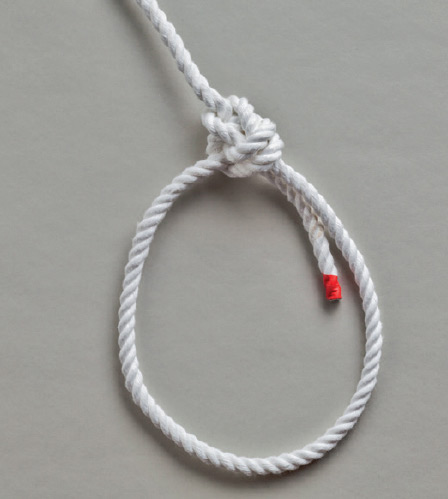
5. The finished Water Bowline. If the working end is too long, it may be secured with an Overhand Knot around the loop, as in the Bowline with .
, but with the working end long enough to form two loops. Make a counterclockwise crossing turn. Pass the long working end through the crossing turn from back to front and pull it through to form the first loop.
Instructions

1. Make an with a bight.

2. Bring the bight around the standing parts.

3. Pass the bight a second time through the crossing turn to complete the Double Overhand Knot on the bight.

4. Pull the loop against the two standing parts to tighten. Fair the knot by laying the four crossing turns close against each other.
Instructions

1. Make a bight anywhere along the rope. Make a counterclockwise underhand crossing turn in the bight.

2. Take the end of the bight over the doubled rope.

3. Pass the bight through the doubled crossing turn from back to front to complete the figure 8.

4. Fair the knot so the doubled strands are parallel all the way through.
is tied with the working end, not on a bight, so it can be used to tie off to closed rings, or to make a loop around an object whose end is not accessible. It creates a fixed single loop. Instructions

1. Start with a standard , leaving a working end somewhat longer than the desired loop. Pass the working end through the ring or around the tie-off point to form the loop.

2. Thread the working end back through the upper crossing turn, next to and parallel with the working end where it exits the figure 8, but in the opposite direction.

3. Pass the working end behind the standing part, always working parallel to the course of the figure 8.

4. Pass the working end through the upper crossing turn of the figure 8, threading it beneath the two strands that form the loop.

5. Still working parallel to the original figure 8, pass the working end around both legs of the loop, then back down through the (now doubled) lower crossing turn, parallel with the standing part.

6. To tighten, hold the working end together with the standing part and pull against the loop. Then release the working end and pull the standing part against the loop.
, it is simple to tie but a little tricky to get the size of the loop exactly as desired. Instructions

1. Make a counterclockwise overhand crossing turn. Form a bight near the working end and pass it through the turn from back to front. In other words, make a and draw it tight.

2. Make a clockwise underhand crossing turn with the working end around the standing part.

3. Pass the working end through the crossing turn to form an .

4. Pull the working-end leg of the loop against the standing part of the line to draw the overhand knots against each other.

5. The finished knot.
tied in the working end around one strand of the loop will help prevent this. It is also a good way to make the knot tidier if the working end is too long. Instructions

1. Tie a standard Bowline (opposite), leaving a longer working end than usual. Make an underhand crossing turn around the working-end leg of the loop.

2. Bring the working end forward, and pass it through the crossing turn from front to back to form an Overhand Knot. Hold the standing part of the rope above the Bowline, and pull the Overhand Knot down and tighten.
with one hand because the other is occupied holding on to something for dear life. This method requires good manual dexterity, but it produces a standard Bowline with all its virtues. Instructions

1. Form the body of the loop in the working end of the rope, then make a bight at the very end. (The bight is optional; it doesn’t form a part of the knot, but it’s easier to manipulate the working end this way.)

2. Holding the bight with your palm down, use your thumb to lift the standing part of the loop.

3. Twist your wrist up so that the standing part of the loop forms a counterclockwise overhand crossing turn over the bight in the working end. Be careful that the crossing turn does not form over your wrist, or you could find yourself entrapped.

4. Undo the bight and pass the working end behind the standing part.

5. Pull the working end through the crossing turn from front to back.

6. Continue to pull the working end through the crossing turn. Depending upon how large you want the loop, you might hold both strands of the new bight that you’ve created around the rope’s standing part and pull them together through the crossing turn.

7. The finished Bowline.
positions the working end outside the loop. It is said to be somewhat less secure than a standard Bowline, but it does place the loop in more complete contact with the object it surrounds. If used as a safety line, it’s more comfortable this way, with the working end away from the torso. Instructions

1. Begin like a standard Bowline. Leaving a long working end, make a small overhand counterclockwise crossing turn and pass the working end through the crossing turn from back to front. As the working end passes through the crossing turn, pass it perpendicular to the standing part.

2. Pass the working end behind the standing part and bring it forward.

3. Bring the working end back through the crossing turn from front to back.

4. Tighten by pulling on the standing part and working end.

5. The finished knot, with the working end on the outside of the loop.
, this one’s simple: just replace the initial crossing turn with two round turns. Instructions

1. Make two counterclockwise round turns in the standing part, leaving the working end long enough to form the loop and complete the knot.

2. Pass the working end through the round turns from back to front.

3. Pass the working end behind the standing part and bring it forward.

4. Pass the working end through the round turns from front to back.

5. Pull the working end and the standing part to tighten. The knot may need to be faired by pulling the standing-part leg of the loop against the standing part of the rope.
around the bight in the working end. It’s especially useful to maintain security in wet, slippery line, yet it can still be untied easily. Instructions

1. Make two counterclockwise overhand crossing turns in the standing part, leaving the working end long enough to form the loop and complete the knot.

2. Shift the lower crossing turn (the one closer to the working end) under the upper one and hold them together.

3. The rest of the procedure is the same as a standard . Pass the working end through the crossing turns from back to front, then behind the standing part.

4. Pass the working end through the crossing turns from front to back. Hold both ends of the bight together in one hand while pulling on the standing part of the rope to tighten the upper Half Hitch. Then pull the standing-part leg of the loop to tighten the lower Half Hitch.

5. The finished Water Bowline. If the working end is too long, it may be secured with an Overhand Knot around the loop, as in the Bowline with .
, but with the working end long enough to form two loops. Make a counterclockwise crossing turn. Pass the long working end through the crossing turn from back to front and pull it through to form the first loop.
Instructions

1. Start with a standard , leaving a working end somewhat longer than the desired loop. Pass the working end through the ring or around the tie-off point to form the loop.

2. Thread the working end back through the upper crossing turn, next to and parallel with the working end where it exits the figure 8, but in the opposite direction.

3. Pass the working end behind the standing part, always working parallel to the course of the figure 8.

4. Pass the working end through the upper crossing turn of the figure 8, threading it beneath the two strands that form the loop.

5. Still working parallel to the original figure 8, pass the working end around both legs of the loop, then back down through the (now doubled) lower crossing turn, parallel with the standing part.

6. To tighten, hold the working end together with the standing part and pull against the loop. Then release the working end and pull the standing part against the loop.
Instructions

1. Make a counterclockwise overhand crossing turn. Form a bight near the working end and pass it through the turn from back to front. In other words, make a and draw it tight.

2. Make a clockwise underhand crossing turn with the working end around the standing part.

3. Pass the working end through the crossing turn to form an .

4. Pull the working-end leg of the loop against the standing part of the line to draw the overhand knots against each other.

5. The finished knot.
tied in the working end around one strand of the loop will help prevent this. It is also a good way to make the knot tidier if the working end is too long. Instructions

1. Tie a standard Bowline (opposite), leaving a longer working end than usual. Make an underhand crossing turn around the working-end leg of the loop.

2. Bring the working end forward, and pass it through the crossing turn from front to back to form an Overhand Knot. Hold the standing part of the rope above the Bowline, and pull the Overhand Knot down and tighten.
with one hand because the other is occupied holding on to something for dear life. This method requires good manual dexterity, but it produces a standard Bowline with all its virtues. Instructions

1. Form the body of the loop in the working end of the rope, then make a bight at the very end. (The bight is optional; it doesn’t form a part of the knot, but it’s easier to manipulate the working end this way.)

2. Holding the bight with your palm down, use your thumb to lift the standing part of the loop.

3. Twist your wrist up so that the standing part of the loop forms a counterclockwise overhand crossing turn over the bight in the working end. Be careful that the crossing turn does not form over your wrist, or you could find yourself entrapped.

4. Undo the bight and pass the working end behind the standing part.

5. Pull the working end through the crossing turn from front to back.

6. Continue to pull the working end through the crossing turn. Depending upon how large you want the loop, you might hold both strands of the new bight that you’ve created around the rope’s standing part and pull them together through the crossing turn.

7. The finished Bowline.
positions the working end outside the loop. It is said to be somewhat less secure than a standard Bowline, but it does place the loop in more complete contact with the object it surrounds. If used as a safety line, it’s more comfortable this way, with the working end away from the torso. Instructions

1. Begin like a standard Bowline. Leaving a long working end, make a small overhand counterclockwise crossing turn and pass the working end through the crossing turn from back to front. As the working end passes through the crossing turn, pass it perpendicular to the standing part.

2. Pass the working end behind the standing part and bring it forward.

3. Bring the working end back through the crossing turn from front to back.

4. Tighten by pulling on the standing part and working end.

5. The finished knot, with the working end on the outside of the loop.
, this one’s simple: just replace the initial crossing turn with two round turns. Instructions

1. Make two counterclockwise round turns in the standing part, leaving the working end long enough to form the loop and complete the knot.

2. Pass the working end through the round turns from back to front.

3. Pass the working end behind the standing part and bring it forward.

4. Pass the working end through the round turns from front to back.

5. Pull the working end and the standing part to tighten. The knot may need to be faired by pulling the standing-part leg of the loop against the standing part of the rope.
around the bight in the working end. It’s especially useful to maintain security in wet, slippery line, yet it can still be untied easily. Instructions

1. Make two counterclockwise overhand crossing turns in the standing part, leaving the working end long enough to form the loop and complete the knot.

2. Shift the lower crossing turn (the one closer to the working end) under the upper one and hold them together.

3. The rest of the procedure is the same as a standard . Pass the working end through the crossing turns from back to front, then behind the standing part.

4. Pass the working end through the crossing turns from front to back. Hold both ends of the bight together in one hand while pulling on the standing part of the rope to tighten the upper Half Hitch. Then pull the standing-part leg of the loop to tighten the lower Half Hitch.

5. The finished Water Bowline. If the working end is too long, it may be secured with an Overhand Knot around the loop, as in the Bowline with .
, but with the working end long enough to form two loops. Make a counterclockwise crossing turn. Pass the long working end through the crossing turn from back to front and pull it through to form the first loop.
Instructions

1. Tie a standard Bowline (opposite), leaving a longer working end than usual. Make an underhand crossing turn around the working-end leg of the loop.

2. Bring the working end forward, and pass it through the crossing turn from front to back to form an Overhand Knot. Hold the standing part of the rope above the Bowline, and pull the Overhand Knot down and tighten.
Instructions

1. Form the body of the loop in the working end of the rope, then make a bight at the very end. (The bight is optional; it doesn’t form a part of the knot, but it’s easier to manipulate the working end this way.)

2. Holding the bight with your palm down, use your thumb to lift the standing part of the loop.

3. Twist your wrist up so that the standing part of the loop forms a counterclockwise overhand crossing turn over the bight in the working end. Be careful that the crossing turn does not form over your wrist, or you could find yourself entrapped.

4. Undo the bight and pass the working end behind the standing part.

5. Pull the working end through the crossing turn from front to back.

6. Continue to pull the working end through the crossing turn. Depending upon how large you want the loop, you might hold both strands of the new bight that you’ve created around the rope’s standing part and pull them together through the crossing turn.

7. The finished Bowline.
positions the working end outside the loop. It is said to be somewhat less secure than a standard Bowline, but it does place the loop in more complete contact with the object it surrounds. If used as a safety line, it’s more comfortable this way, with the working end away from the torso. Instructions

1. Begin like a standard Bowline. Leaving a long working end, make a small overhand counterclockwise crossing turn and pass the working end through the crossing turn from back to front. As the working end passes through the crossing turn, pass it perpendicular to the standing part.

2. Pass the working end behind the standing part and bring it forward.

3. Bring the working end back through the crossing turn from front to back.

4. Tighten by pulling on the standing part and working end.

5. The finished knot, with the working end on the outside of the loop.
, this one’s simple: just replace the initial crossing turn with two round turns. Instructions

1. Make two counterclockwise round turns in the standing part, leaving the working end long enough to form the loop and complete the knot.

2. Pass the working end through the round turns from back to front.

3. Pass the working end behind the standing part and bring it forward.

4. Pass the working end through the round turns from front to back.

5. Pull the working end and the standing part to tighten. The knot may need to be faired by pulling the standing-part leg of the loop against the standing part of the rope.
around the bight in the working end. It’s especially useful to maintain security in wet, slippery line, yet it can still be untied easily. Instructions

1. Make two counterclockwise overhand crossing turns in the standing part, leaving the working end long enough to form the loop and complete the knot.

2. Shift the lower crossing turn (the one closer to the working end) under the upper one and hold them together.

3. The rest of the procedure is the same as a standard . Pass the working end through the crossing turns from back to front, then behind the standing part.

4. Pass the working end through the crossing turns from front to back. Hold both ends of the bight together in one hand while pulling on the standing part of the rope to tighten the upper Half Hitch. Then pull the standing-part leg of the loop to tighten the lower Half Hitch.

5. The finished Water Bowline. If the working end is too long, it may be secured with an Overhand Knot around the loop, as in the Bowline with .
, but with the working end long enough to form two loops. Make a counterclockwise crossing turn. Pass the long working end through the crossing turn from back to front and pull it through to form the first loop.
Instructions

1. Begin like a standard Bowline. Leaving a long working end, make a small overhand counterclockwise crossing turn and pass the working end through the crossing turn from back to front. As the working end passes through the crossing turn, pass it perpendicular to the standing part.

2. Pass the working end behind the standing part and bring it forward.

3. Bring the working end back through the crossing turn from front to back.

4. Tighten by pulling on the standing part and working end.

5. The finished knot, with the working end on the outside of the loop.
Instructions

1. Make two counterclockwise round turns in the standing part, leaving the working end long enough to form the loop and complete the knot.

2. Pass the working end through the round turns from back to front.

3. Pass the working end behind the standing part and bring it forward.

4. Pass the working end through the round turns from front to back.

5. Pull the working end and the standing part to tighten. The knot may need to be faired by pulling the standing-part leg of the loop against the standing part of the rope.
around the bight in the working end. It’s especially useful to maintain security in wet, slippery line, yet it can still be untied easily. Instructions

1. Make two counterclockwise overhand crossing turns in the standing part, leaving the working end long enough to form the loop and complete the knot.

2. Shift the lower crossing turn (the one closer to the working end) under the upper one and hold them together.

3. The rest of the procedure is the same as a standard . Pass the working end through the crossing turns from back to front, then behind the standing part.

4. Pass the working end through the crossing turns from front to back. Hold both ends of the bight together in one hand while pulling on the standing part of the rope to tighten the upper Half Hitch. Then pull the standing-part leg of the loop to tighten the lower Half Hitch.

5. The finished Water Bowline. If the working end is too long, it may be secured with an Overhand Knot around the loop, as in the Bowline with .
, but with the working end long enough to form two loops. Make a counterclockwise crossing turn. Pass the long working end through the crossing turn from back to front and pull it through to form the first loop.
Instructions

1. Make two counterclockwise overhand crossing turns in the standing part, leaving the working end long enough to form the loop and complete the knot.

2. Shift the lower crossing turn (the one closer to the working end) under the upper one and hold them together.

3. The rest of the procedure is the same as a standard . Pass the working end through the crossing turns from back to front, then behind the standing part.

4. Pass the working end through the crossing turns from front to back. Hold both ends of the bight together in one hand while pulling on the standing part of the rope to tighten the upper Half Hitch. Then pull the standing-part leg of the loop to tighten the lower Half Hitch.

5. The finished Water Bowline. If the working end is too long, it may be secured with an Overhand Knot around the loop, as in the Bowline with .
